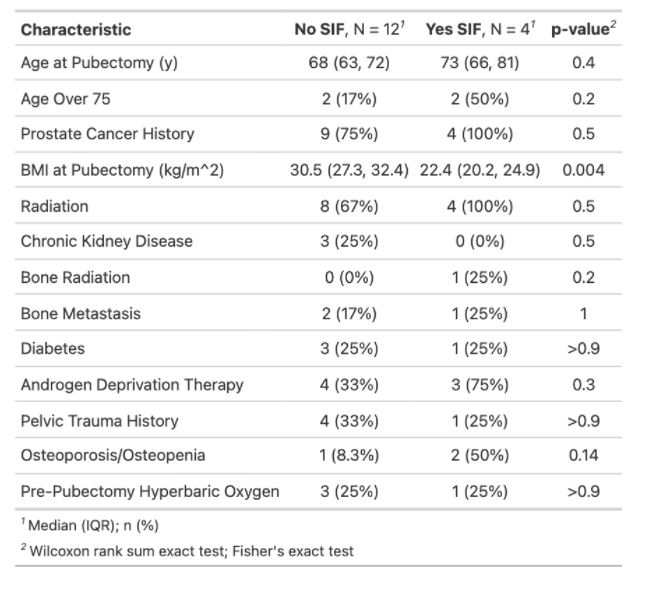Back
Poster, Podium & Video Sessions
Moderated Poster
MP25: Trauma/Reconstruction/Diversion: Ureter (including Pyeloplasty) and Bladder Reconstruction (including fistula), Augmentation, Substitution, Diversion
MP25-17: Pelvic Insufficiency Fracture -- an underrecognized cause of pain after pubectomy
Saturday, May 14, 2022
10:30 AM – 11:45 AM
Location: Room 228
Molly DeWitt-Foy, Ranveer Vasdev*, Sean Elliott, Minneapolis, MN

Ranveer Vasdev, MS
University of Minnesota
Poster Presenter(s)
Introduction: Pubectomy is traditionally used in repair of complex pelvic fracture urethral injuries (PFUI) but is now increasingly used in the management of pubic osteomyelitis that results from prostate cancer treatment. Classically, pubectomy after PFUI is thought to not disrupt the stability of the pelvic ring. However, this has not been studied in detail in patients with osteomyelitis, who often have comorbid conditions that may alter said stability and increase risk of fracture.). Our aim is to document the incidence, presentation and risk factors of sacral insufficiency fracture (SIF) in patients who have undergone pubectomy for osteomyelitis.
Methods: Retrospective chart review was performed of patients undergoing pubectomy for osteomyelitis at a single institution from 2016-2021.. Descriptive statistics and univariate analysis were performed using R. Wilcoxon rank-sum test and Fisher exact test were used as appropriate.
Results: Sixteen patients underwent pubectomy for osteomyelitis, all after prostate radiotherapy. Mean age was 68 years and mean BMI 28.5. Six (37.5%) underwent cystectomy with urinary diversion at the time of pubectomy, 4 (23.5%) had cystectomy prior to pubectomy. Eleven (68.7%) had postoperative cross-sectional pelvic imaging, of which 3 (25%) were found to have a new SIF; one additional patient had SIF prior to pubectomy. Three SIFs were detected on MRI and one on CT scan. All patients were symptomatic of SIF, most commonly with new pelvic or perineal pain. The median BMI of patients with SIF was significantly lower than those without SIF (22.4 v 30.5, p value = 0.004). Age, chronic kidney disease, bone metastasis, hyperbaric oxygen, diabetes, and androgen deprivation therapy were not significantly associated with risk of SIF.
Conclusions: Sacral insufficiency fracture is a rarely described sequela of pubectomy for osteomyelitis. Lower BMI is significantly associated with SIF, perhaps indicative of overall frailty.
Source of Funding: NA

Methods: Retrospective chart review was performed of patients undergoing pubectomy for osteomyelitis at a single institution from 2016-2021.. Descriptive statistics and univariate analysis were performed using R. Wilcoxon rank-sum test and Fisher exact test were used as appropriate.
Results: Sixteen patients underwent pubectomy for osteomyelitis, all after prostate radiotherapy. Mean age was 68 years and mean BMI 28.5. Six (37.5%) underwent cystectomy with urinary diversion at the time of pubectomy, 4 (23.5%) had cystectomy prior to pubectomy. Eleven (68.7%) had postoperative cross-sectional pelvic imaging, of which 3 (25%) were found to have a new SIF; one additional patient had SIF prior to pubectomy. Three SIFs were detected on MRI and one on CT scan. All patients were symptomatic of SIF, most commonly with new pelvic or perineal pain. The median BMI of patients with SIF was significantly lower than those without SIF (22.4 v 30.5, p value = 0.004). Age, chronic kidney disease, bone metastasis, hyperbaric oxygen, diabetes, and androgen deprivation therapy were not significantly associated with risk of SIF.
Conclusions: Sacral insufficiency fracture is a rarely described sequela of pubectomy for osteomyelitis. Lower BMI is significantly associated with SIF, perhaps indicative of overall frailty.
Source of Funding: NA

.jpg)
.jpg)